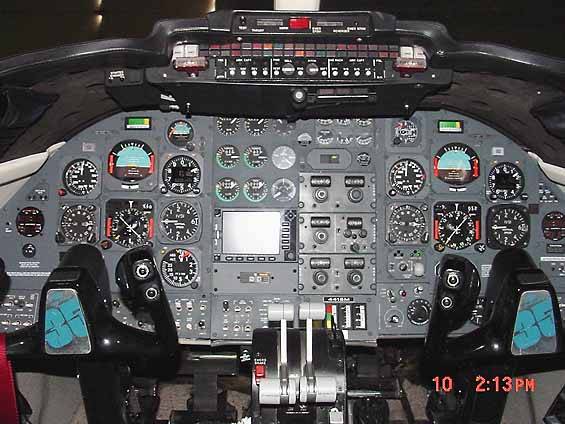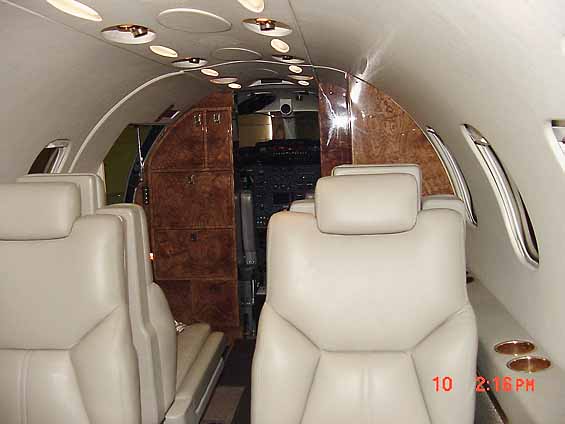


Aircraft Description
Background/History
The Learjet 35A represents a significant development in the long line of aircraft descended from Bill Lear’s original Lear 23, which first flew in October 1963. While all of the 20-series Learjets were powered by turbojet engines, the current generation of turbofan-powered Learjets began in August 1973 with the first flight of the Model 35. Equipped with a pair of Garrett AiResearch TFE731 turbofan engines, the Learjet 35 began a new era of quiet, fuel-efficient operation in comparison to the turbojet aircraft of the previous decade. The Model 35 is optimized for eight passengers, while its longer-range variant, the Model 36, has a greater fuel capacity but accommodates only six passengers. Both the 35 and the 36 were granted FAA certification in July 1974. The Learjet 35A and 36A were introduced in 1976 and feature an increase in MTOW over their predecessors. The 35A continued in production through 1993 with a toal run of 610 aircraft.
Power
The Learjet 35A is powered by a pair of AlliedSignal TFE731-2-2B turbofans rated at 3,500 lbs. of thrust each. Inspection interval on the engine cores is 4,200 hours.
Avionics
Learjet 35A instrument panels have evolved over the years from the analog displays of the early model years to the digital cockpits of later years. Recent-year 35A’s featured Collins nav/comm/ident radios in duplicate as standard equipment and offered as optional equipment a Collins EFIS package with right- and left-side primary flight displays and a large center multi-function display, color weather radar, and FMS.
Design Features
The Learjet 35A is a medium-range, twin turbofan-powered business aircraft configured as a cantilever low-wing monoplane with a slight leading-edge sweep, cantilever T-tail, and retractable tricycle landing gear with two wheels on each main gear unit. The fuselage of the Model 35 is stretched 1.1ft. forward of the wing beyond that of the Model 25, which itself employed a 4.2 ft. stretch over the original Model 23/24 fuselage. The fuselage stretch on the Model 35 was necessary to offset the additional weight of the TFE731 turbofan engines over that of the earlier CJ610s used on the Model 25 series aircraft. Each wing has 2ft. extensions on each tip and retains the familiar wingtip tanks of earlier Learjets. The 35A model offered a maximum takeoff weight of 18,300 lbs.
Accomodations
The Learjet 35A is a small-sized business aricraft normally configured for six to seven passengers. The typical arrangement has a full-width divan on the aft bulkhead of the cabin, and four forward-facing seats. A refreshment center is normally positioned along the starboard cabin wall just forward of the seating area. A side-facing lavatory is located in the forward cabin opposite the airstair door and can be used as a jumpseat for an additional passenger. The 35A utilizes the same fuselage cross-section as the Learjet 25 series, with a cabin height of 4.3ft., cabin width of 4.9ft. and length of 12.9ft. Approximately 40cu.ft. of baggage storage is located behind the aft, fold-down divan seat and is accessable only from inside the cabin.
| General | Learjet 35A, LR-35A | |||
|---|---|---|---|---|
| Category | Jet < 20,000 lbs. | |||
| Years Aircraft Manufactured | 1976 – 1993 | |||
| Serial Number Range | 067 – 676 | |||
| Retail High Price | $1,600,000.00 / 1,255,520.00€ | |||
| Retail Low Price | $475,000.00 / 372,732.50€ | |||
| Characteristics | Learjet 35A, LR-35A | |||
| Seating | 2 + 7/10 | |||
| Wing Loading | 72.2 | |||
| Power Loading | 2.6 | |||
| Noise(EPNdB): Takeoff/Sideline/Approach | 83.7/91.4 | |||
| External Dimensions (ft) | Learjet 35A, LR-35A | |||
| External Length | 48.7 | |||
| External Height | 12.3 | |||
| External Span | 39.5 | |||
| Internal Dimensions (ft) | Learjet 35A, LR-35A | |||
| Internal Length (Overall/Net Height) | 12.9 | |||
| Internal Height | 4.3 | |||
| Internal Width (Max/Floor) | 4.9/3.0 | |||
| Baggage | Learjet 35A, LR-35A | |||
| External: Cu.Ft./Lb. | N/A | |||
| External: Cu.Ft./Lb. | N/A | |||
| Power | Learjet 35A, LR-35A | |||
| Engines | 2 Hon TFE731-2-2B | |||
| Output (lbs ea.)/Flat Rating | 3,500 | |||
| Inspection Interval | 4200c | |||
| Data based on latest manufactured year | ||||



